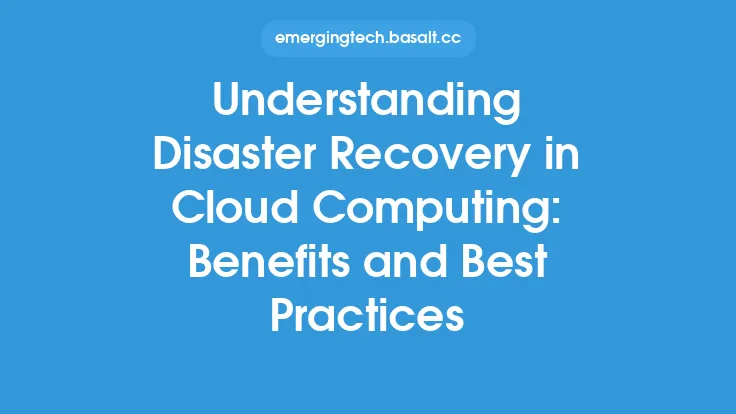When it comes to disaster recovery in cloud computing, having a well-planned and tested strategy is crucial for ensuring business continuity and minimizing downtime. A cloud-based disaster recovery plan is designed to enable organizations to quickly recover from disruptions, such as natural disasters, cyberattacks, or equipment failures, by replicating their data and applications in the cloud. However, simply having a plan in place is not enough; it's essential to test and validate the plan regularly to ensure its effectiveness.
Introduction to Testing and Validation
Testing and validation are critical components of a cloud-based disaster recovery plan. These processes involve simulating disaster scenarios to evaluate the plan's ability to recover data and applications, as well as to identify potential weaknesses and areas for improvement. By testing and validating the plan, organizations can ensure that their disaster recovery strategy is robust, reliable, and able to meet their business continuity needs. This includes verifying that all necessary data and applications can be recovered within the required timeframe, known as the Recovery Time Objective (RTO), and that data integrity and consistency are maintained throughout the recovery process.
Types of Testing
There are several types of testing that can be performed to validate a cloud-based disaster recovery plan, including:
- Tabletop exercises: These are simulated disaster scenarios that involve walking through the disaster recovery plan to identify potential issues and areas for improvement. Tabletop exercises are typically conducted in a conference room setting and involve key stakeholders and team members.
- Functional exercises: These tests involve simulating a disaster scenario to evaluate the plan's ability to recover data and applications. Functional exercises can be conducted in a controlled environment, such as a test lab, and may involve actual data and applications.
- Full-scale exercises: These tests involve simulating a disaster scenario in a production environment, using actual data and applications. Full-scale exercises are typically more comprehensive and realistic than functional exercises but may also be more disruptive to business operations.
- Automated testing: This involves using automated tools and scripts to test the disaster recovery plan, such as verifying that data can be recovered within the required RTO.
Best Practices for Testing
To ensure that testing is effective, organizations should follow best practices, such as:
- Test regularly: Testing should be performed on a regular basis, such as quarterly or bi-annually, to ensure that the disaster recovery plan remains up-to-date and effective.
- Test thoroughly: Testing should be comprehensive and cover all aspects of the disaster recovery plan, including data recovery, application recovery, and network connectivity.
- Involve key stakeholders: Testing should involve key stakeholders and team members, including IT staff, business leaders, and external partners.
- Use realistic scenarios: Testing should involve realistic disaster scenarios, such as a hurricane or cyberattack, to simulate the types of disruptions that may occur.
- Monitor and evaluate: Testing should involve monitoring and evaluating the results, including identifying areas for improvement and implementing changes to the disaster recovery plan.
Validation and Verification
Validation and verification are critical components of testing a cloud-based disaster recovery plan. Validation involves verifying that the plan is able to recover data and applications within the required RTO, while verification involves verifying that the recovered data and applications are accurate and consistent. To validate and verify the plan, organizations can use various metrics, such as:
- Recovery Time Objective (RTO): The time it takes to recover data and applications after a disaster.
- Recovery Point Objective (RPO): The point in time to which data can be recovered after a disaster.
- Data integrity: The accuracy and consistency of recovered data.
- Application functionality: The ability of recovered applications to function correctly.
Tools and Technologies
There are various tools and technologies that can be used to test and validate a cloud-based disaster recovery plan, including:
- Cloud-based disaster recovery platforms: These platforms provide automated disaster recovery capabilities, such as data replication and application recovery.
- Disaster recovery software: This software provides tools and features for testing and validating disaster recovery plans, such as simulation and automation.
- Monitoring and analytics tools: These tools provide real-time monitoring and analytics capabilities, such as performance metrics and error reporting.
- Automation scripts: These scripts can be used to automate testing and validation, such as verifying that data can be recovered within the required RTO.
Challenges and Limitations
Testing and validating a cloud-based disaster recovery plan can be challenging, particularly in complex and distributed environments. Some common challenges and limitations include:
- Scalability: Testing and validating a disaster recovery plan can be resource-intensive, particularly in large and complex environments.
- Complexity: Cloud-based disaster recovery plans can be complex, involving multiple data centers, applications, and stakeholders.
- Cost: Testing and validating a disaster recovery plan can be costly, particularly if it involves significant resources and infrastructure.
- Time: Testing and validating a disaster recovery plan can be time-consuming, particularly if it involves comprehensive and realistic scenarios.
Conclusion
Testing and validating a cloud-based disaster recovery plan is essential for ensuring business continuity and minimizing downtime. By following best practices, such as testing regularly and thoroughly, involving key stakeholders, and using realistic scenarios, organizations can ensure that their disaster recovery strategy is robust, reliable, and able to meet their business continuity needs. While there are challenges and limitations to testing and validating a cloud-based disaster recovery plan, the benefits of ensuring business continuity and minimizing downtime make it a critical component of any cloud computing strategy.





